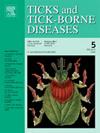An official South African species checklist from the National Tick Collection of South Africa (Gertrud Theiler Tick Museum)
IF 3.4
2区 医学
Q2 INFECTIOUS DISEASES
引用次数: 0
Abstract
Ticks play a crucial role in ecosystem dynamics and disease transmission, necessitating accurate species identification for epidemiological and ecological research. South Africa, despite occupying only 0.82 % of the world's land area, harbors approximately 11 % of global tick species richness. This study provides an updated, authoritative checklist of South African tick species curated by the National Tick Collection of South Africa (NTCSA), housed at the Agricultural Research Council – Onderstepoort Veterinary Research (ARC![]() OVR). Previous lists for South Africa presented outdated taxonomic classifications and incomplete data on taxonomic taxa. The NTCSA checklist aims to correct inaccuracies, incorporating the most recent literature, molecular systematics, and expert curation. A total of 110 tick species across three families (Ixodidae, Argasidae, Nuttalliellidae) are documented, with corrections to genera classifications and species distributions indicated. This list serves as a reference for researchers, veterinarians, and policymakers involved in tick diversity, vector control, and conservation efforts. Continuous updates integrating morphological and molecular assessments will further enhance our understanding of tick diversity and distribution in South Africa. The wide extralimital distribution of various species extend the taxonomic observations to the African continent, while the general taxonomic observations presented summarize our understanding of tick taxonomy at global level.
OVR). Previous lists for South Africa presented outdated taxonomic classifications and incomplete data on taxonomic taxa. The NTCSA checklist aims to correct inaccuracies, incorporating the most recent literature, molecular systematics, and expert curation. A total of 110 tick species across three families (Ixodidae, Argasidae, Nuttalliellidae) are documented, with corrections to genera classifications and species distributions indicated. This list serves as a reference for researchers, veterinarians, and policymakers involved in tick diversity, vector control, and conservation efforts. Continuous updates integrating morphological and molecular assessments will further enhance our understanding of tick diversity and distribution in South Africa. The wide extralimital distribution of various species extend the taxonomic observations to the African continent, while the general taxonomic observations presented summarize our understanding of tick taxonomy at global level.
南非国家蜱虫收藏的官方南非物种清单(格特鲁德·泰勒蜱虫博物馆)
蜱在生态系统动力学和疾病传播中起着至关重要的作用,需要准确的物种鉴定来进行流行病学和生态学研究。南非虽然只占世界陆地面积的0.82%,却拥有全球约11%的蜱虫物种丰富度。这项研究提供了一份最新的、权威的南非蜱虫物种清单,由南非国家蜱虫收集中心(NTCSA)管理,该中心设在农业研究委员会-奥德斯特波特兽医研究中心(ARCOVR)。南非以前的分类分类表存在过时的分类分类和不完整的分类群数据。nctsa检查表旨在纠正不准确,结合最新的文献,分子系统学和专家策展。记录了蜱属3科(蜱科、蠓科、蠓科)共110种,并对属分类和种分布进行了更正。这份清单可作为研究人员、兽医和政策制定者参与蜱虫多样性、媒介控制和保护工作的参考。整合形态和分子评估的持续更新将进一步增强我们对南非蜱虫多样性和分布的了解。广泛的物种外分布将分类观察扩展到非洲大陆,而一般分类观察则总结了我们在全球水平上对蜱类分类的认识。
本文章由计算机程序翻译,如有差异,请以英文原文为准。
求助全文
约1分钟内获得全文
求助全文
来源期刊

Ticks and Tick-borne Diseases
INFECTIOUS DISEASES-MICROBIOLOGY
CiteScore
6.90
自引率
12.50%
发文量
185
审稿时长
6-12 weeks
期刊介绍:
Ticks and Tick-borne Diseases is an international, peer-reviewed scientific journal. It publishes original research papers, short communications, state-of-the-art mini-reviews, letters to the editor, clinical-case studies, announcements of pertinent international meetings, and editorials.
The journal covers a broad spectrum and brings together various disciplines, for example, zoology, microbiology, molecular biology, genetics, mathematical modelling, veterinary and human medicine. Multidisciplinary approaches and the use of conventional and novel methods/methodologies (in the field and in the laboratory) are crucial for deeper understanding of the natural processes and human behaviour/activities that result in human or animal diseases and in economic effects of ticks and tick-borne pathogens. Such understanding is essential for management of tick populations and tick-borne diseases in an effective and environmentally acceptable manner.
 求助内容:
求助内容: 应助结果提醒方式:
应助结果提醒方式:


